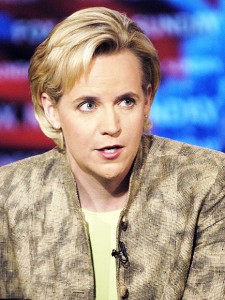
Mary Cheney, former Vice President Cheney’s daughter, is raising a child with her lesbian partner. Politics aside, what kind of family environment is best for the health and development of children and, by extension, the nation at large?
With all due respect to Cheney and her partner, the majority of more than 30 years’ worth of social science research shows that children do best on every measure of well-being when their married mother and father raise them. That is not to say Cheney and Poe will not love their child. But love alone is not enough to guarantee healthy growth and development. The two most loving women in the world cannot provide a daddy for a little boy—any more than the two most loving men can be complete role models for a little girl.
The voices that argue otherwise tell us more about our politically correct culture than they do about what children really need. The fact remains that gender matters—perhaps nowhere more than in child-rearing. In his book “Fatherneed: Why Father Care Is as Essential as Mother Care for Your Child” Dr. Kyle Pruett of Yale Medical School explains the unique value of fathers. Pruett says dads are critically important simply because “fathers do not mother.” Psychology Today explained in 1996 that “fatherhood turns out to be a complex and unique phenomenon with huge consequences for the emotional and intellectual growth of children.” A father, as a male parent, makes unique contributions to the task of parenting that a mother cannot emulate, and vice versa.
According to educational psychologist Carol Gilligan, mothers tend to stress sympathy, grace, and care for their children, while fathers emphasize justice, fairness, and duty. Moms give a child a sense of hopefulness; dads provide a sense of right and wrong and its consequences. Other researchers have determined that boys are not born with an understanding of “maleness.” They have to learn it, ideally from their fathers.
But set aside the scientific findings for a minute. Isn’t there something in our hearts that tells us, intuitively that children need a mother and a father? Admittedly, that ideal is not always possible. Divorce, death, abandonment, and unwed pregnancy have resulted in an ever-growing number of single-parent families in this culture. We admire the millions of men and women who have risen to the challenge of parenting alone and are meeting their difficult responsibilities with courage and determination. Still, most of them, if asked, would say that raising children is a two-person job best accomplished by a mother and father.
In raising these issues, Focus on the Family does not desire to harm or insult women such as Cheney and Poe. Rather, our conviction is that birth and adoption are the purview of married heterosexual couples. Traditional marriage is God’s design for the family and is rooted in biblical truth. When that divine plan is implemented, children have the best opportunity to thrive. That’s why public policy as it relates to families must be based not solely on the desires of adults but rather on the needs of children and what is best for society at large.

This is a lesson we should have learned from a no-fault divorce. Because adults wanted to dissolve difficult marriages with fewer strings attached, reformers made it easier in the late 1960s to dissolve nuclear families. Though there are exceptions, the legacy of no-fault divorce is countless shattered lives within three generations, adversely affecting children’s behavior, academic performance, and mental and physical health. No-fault divorce reflected our selfish determination to do what was convenient for adults, and it has been, on balance, a disaster.
We should not enter into yet another untested and far-reaching social experiment, this one driven by the desires of same-sex couples to bear and raise children. The traditional family is still the cornerstone on which future generations’ well-being depends, thanks to more than 5,000 years of human history.
JAMES C. DOBSON
First published in Time Magazine

